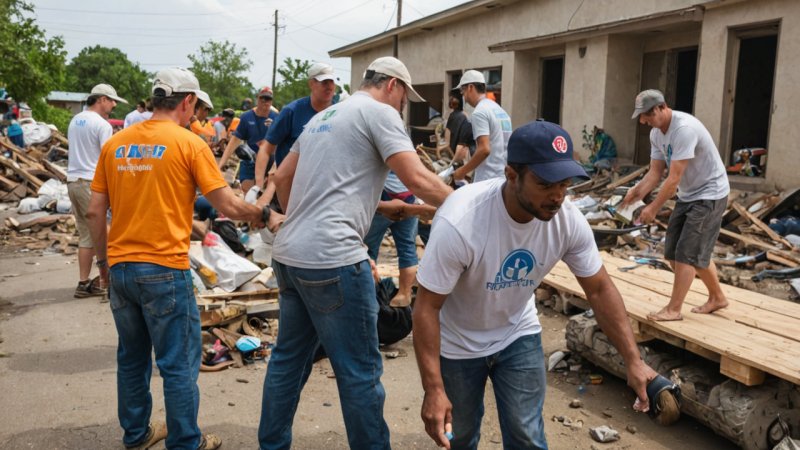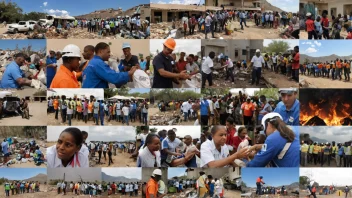Disasters can strike at any moment, leaving countless individuals and communities in dire need of assistance. Whether it’s a natural calamity like a hurricane, earthquake, or flood, or a humanitarian crisis such as conflict or refugee displacement, the need for compassionate volunteers is more crucial than ever. Engaging in disaster relief operations not only helps those affected but also enriches your own life with experiences that foster empathy, teamwork, and resilience. This guide aims to provide you with the necessary steps to get involved in disaster relief efforts, offering insights into organizations, skills needed, and the impact of your involvement.
Understanding the Scope of Disaster Relief
Disaster relief encompasses a wide range of activities aimed at providing support to those affected by disasters. This includes immediate response efforts like search and rescue, medical assistance, food distribution, and shelter provision, as well as longer-term recovery efforts such as rebuilding infrastructure and offering psychological support. Understanding the scope of disaster relief is crucial, as it helps you identify where your skills and interests align with the needs of communities in crisis.
Researching Organizations and Opportunities
Before diving into volunteer work, it is essential to research organizations that are actively involved in disaster relief. Some well-known organizations include:
- The Red Cross: Known for its rapid response to emergencies, the Red Cross provides a wide range of services from health services to shelter.
- Doctors Without Borders: This organization focuses on providing medical care in regions affected by crises.
- Team Rubicon: A unique organization that combines the skills of military veterans with first responders to assist in disaster recovery.
- Habitat for Humanity: While primarily known for building homes, they also engage in rebuilding communities after disasters.
In addition to these, many local organizations and community groups also need volunteers during disasters. Check local volunteer centers or websites like VolunteerMatch to find opportunities that suit your availability and skill set.
Assessing Your Skills and Availability
Volunteering in disaster relief requires a mix of skills, and it’s important to assess what you can bring to the table. Consider the following:
- Medical Skills: If you have training in healthcare, you can assist medical teams in providing care.
- Logistical Skills: Organizing supplies, transportation, and shelter management are critical in disaster scenarios.
- Communication Skills: Helping with outreach and information dissemination can be vital in coordinating relief efforts.
- Emotional Support: Providing psychological first aid or emotional support to those affected can be incredibly beneficial.
Also, think about your availability. Many organizations offer opportunities for both short-term deployments during an immediate crisis and long-term volunteer roles focused on recovery efforts.
Preparing for Volunteer Work
Once you have identified an organization and assessed your skills, preparation is key. Here are some steps to take:
- Training: Many organizations provide training sessions for new volunteers. This training often covers safety protocols, disaster response techniques, and specific skills related to the organization’s mission.
- Gathering Supplies: Depending on your role, you may need to prepare personal supplies such as protective gear, first aid kits, and comfortable clothing.
- Staying Informed: Keep up to date with current events and ongoing disasters. Understanding the context of your volunteer work will enhance your effectiveness.
Engaging in Volunteer Work
When you arrive at a disaster site, it’s important to remain flexible and open-minded. Each disaster response situation is unique, and roles can change quickly based on the needs of the community. Here are some tips for successful engagement:
- Follow Instructions: Always adhere to the guidance of experienced team leaders and local authorities.
- Work as a Team: Collaboration is essential in high-pressure situations. Support your teammates and communicate openly.
- Practice Self-Care: Disaster relief can be emotionally and physically challenging. Take breaks, stay hydrated, and reach out for support if needed.
Making a Long-Term Impact
While immediate disaster relief efforts are vital, consider how you can contribute to long-term recovery and community resilience. This can include:
- Advocacy: Raise awareness about the issues faced by disaster-affected communities and advocate for policies that support them.
- Education: Share your experiences and knowledge about disaster preparedness and resilience with your community.
- Continued Involvement: Stay engaged with the organization you volunteered with and consider taking on additional roles such as training future volunteers.
Conclusion
Volunteering in disaster relief operations is a profound way to contribute to the wellbeing of individuals and communities facing crisis. By understanding the scope of disaster relief, researching organizations, assessing your skills, and preparing thoughtfully, you can make a meaningful impact. Your involvement can bring hope and healing to those in need while fostering a sense of community and resilience. Whether you choose to volunteer during an acute disaster or support long-term recovery efforts, your actions can inspire others and create lasting change in the world.






